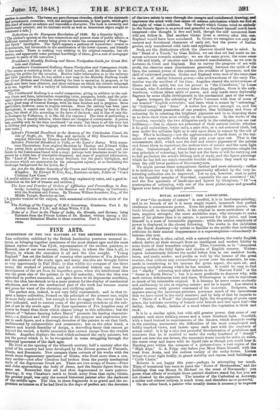ROYAL ACADEMY: THE LAN DSCAPES. If ever." the modesty of nature
" is needful, it is in landscape-painting; and in no branch of art is it more amply repaid, insomuch that perfect obedience is consummate power. Even the painter of feebler genius, who lends himself, in thorough faith, to his original in mere portraiture of na- ture, acquires strength; the more ambitious man, who attempts to make more of his picture than is in nature, is accursed for his pains, and loses himself in a mess of intractable pigments; while the utmost amplitude of power is displayed in the closest following. The works in the exhibition of the Royal Academy—by artists so familiar to the public that individual criticism on their annual reappearance is a supererogation—abundantly il- lustrate this text. Some, of what is often called, with a natural fondness, the really English school, derive all their strength from an intelligent and modest fidelity to some traits of their boundless original. Thus, Cressviok, as in "chequered shade," catches the fitful lights and shades of English scenery. Wither- ington industriously follows the model before him in our meadow lands, lanes, and rustic nooks; and profits so well by the lessons of the great teacher, that without any extraordinary power over his materials, he suc- ceeds in transferring to his canvass the green aspect, the open air, and glancing sunlight among which he has studied. It would be easy to find out " chalky" colouring and other defects in the " Harvest Field " or the " Scene in North Devon"; but it is more profitable to discover why, with such serious deficiencies here and there, Witherington is able to reproduce so much of his inimitable original. It is because he never ceases modestly and assiduously to aim at copying nature: and he is repaid. Lee attains a similar success, with greater command of his materials. Redgrave, who appears among the landscape-painters, possesses much of the earnestness that we have noted in the early masters; and by help of that imparts to the " Skirts of a Wood" the chequered light, the deepening rt of green upon green, the intricate covering of branch over branch and leaf upon leaf—the stalky, leafy, shady, fashion of a wood where the vegetation is thick and rank. It is in a similar spirit, but with still greater power, that some of our painters seek more striking scenes and a more Southern light. Stanfield, with a hand trained to requirements of the theatre, which demands reality in the painting, encounters the difficulties of the most complicated and boldly-marked views, and insists upon each part with the emphasis of actual relief: it is by a nice but powerful discrimination of gradations and contrasts that he is enabled to make the rocky headland of " Amalfi" stand out into the sea-breeze, the mountain waste recede for miles on miles, the water sway and heave with its liquid talc as though you could hear it. Harding puts within the compass of a picture-frame a vast region of the " High Alps." G. A. Fripp sets before you Mont Blanc himself, with the road from Aosta, and the endless variety of the rocky forma. Linton brings to your sight bodily, in grand stability and repose, such buildings as " Corfe Castle." Roberts is not happy this year—perhaps in attempting too much. Tints of unnatural hue seem to paint the " Ruins of Hermonthes," and the Normandy: you
buildings that cap Mount St. Michael on the coast of Nor
guess what effects of sunlight those painted shadows stand for, but you are not cheated by the pigments. The interior of the Cathedral at Antwerp, a colder and soberer subject, is much truer, and therefore more powerful.
On the other hand, a painter who usually deems it necessary to improve
on the creation, seems this year much more content with the outward world, and is pleased to bring Danby nearer to nature: the "Evening Gun" is a Danby sunset, but more like a real sunset than usual, though still smack- ing of the sublime teaboard, and adorned by a ship of yards a mile wide. Having, in the attempt to reproduce the "Eve of the Deluge," wandered from the plain light of nature, Linnell is contending in a hopeless chaos of unconcooted pigments. Sidney Cooper is usually classed among cattle-painters; but his back- grounds are landscapes of a high order: the most masterly landscape in the exhibition is that from " the White Hall Meadows, near Canterbury,"-a flat meadow scene, with cows standing about, and a flood of moist warm sunlight over all. In fact, Cooper treats even his animals in the manner of a landscape-painter: excellently as their characteristics are caught-see the cows in the view:" Above the Slate-quarries on the River Ogweir "- they are, if we mistake not, painted with less minute elaboration than he used to employ, but rather fall in with other objects of the scene in the broad disposal of light and shadow, of chiaroscuro, and of colour. Cooper paints with the manner of a man whose life is passed in the open air, palette in hand: he catches the transient characteristics of the scene-the slow turn of the cow's observant eye-every bend of her restless tail-every form and tint of the gliding sun-mist-every changeful aspect of local colour as it varies with position, distance, or the incidence of light. What he includes visually in his pictures is so vividly and fully brought to the sight, that the other senses are cheated, and you can catch in the thick evening air the murmur of the country.

























 Previous page
Previous page